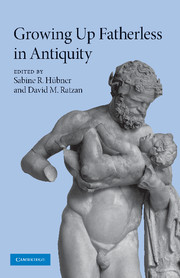Book contents
- Frontmatter
- Contents
- List of figures
- List of tables
- List of contributors
- Acknowledgments
- Note on abbreviations
- INTRODUCTION
- 1 Fatherless antiquity? Perspectives on “fatherlessness” in the ancient Mediterranean
- PART I COPING WITH DEMOGRAPHIC REALITIES
- PART II VIRTUAL FATHERLESSNESS
- 6 Bastardy and fatherlessness in ancient Greece
- 7 Fatherlessness and formal identification in Roman Egypt
- PART III ROLES WITHOUT MODELS
- PART IV RHETORIC OF LOSS
- Bibliography
- Index
7 - Fatherlessness and formal identification in Roman Egypt
Published online by Cambridge University Press: 30 July 2009
- Frontmatter
- Contents
- List of figures
- List of tables
- List of contributors
- Acknowledgments
- Note on abbreviations
- INTRODUCTION
- 1 Fatherless antiquity? Perspectives on “fatherlessness” in the ancient Mediterranean
- PART I COPING WITH DEMOGRAPHIC REALITIES
- PART II VIRTUAL FATHERLESSNESS
- 6 Bastardy and fatherlessness in ancient Greece
- 7 Fatherlessness and formal identification in Roman Egypt
- PART III ROLES WITHOUT MODELS
- PART IV RHETORIC OF LOSS
- Bibliography
- Index
Summary
INTRODUCTION
My contribution to this volume is concerned with the phenomenon of fatherlessness as it is attested in the papyri and ostraca of Roman Egypt. The kind of fatherlessness considered in this paper is not to be understood as the physical, or possibly even actual, absence of a father, such as would make one a child of a single-parent family or an orphan. Rather, it is a legal formality that figures in the documents from Egypt in the Roman period, a compulsory self-designation for any free individual who could not establish legitimate paternity and was thus forbidden from using the name of his or her father (a patronymic) for the purposes of legal self-identification. Such individuals are attested fairly frequently and the terms used to describe them are apatōr (literally, “without a father” or “fatherless”) and chrēmatizōn mētros (“officially described [by the name] of the mother”). Both are legal terms to mark a fatherless person, who must give his or her mother's name instead of the normal patronymic when officially declaring his or her identity. They are synonymous and have roughly the same chronological span, as we shall see, but they are not interchangeable: the former is the more common of the two, since it is used in all parts of Egypt, other than Oxyrhynchus, where the latter is used instead.
- Type
- Chapter
- Information
- Growing Up Fatherless in Antiquity , pp. 120 - 138Publisher: Cambridge University PressPrint publication year: 2009
- 1
- Cited by



